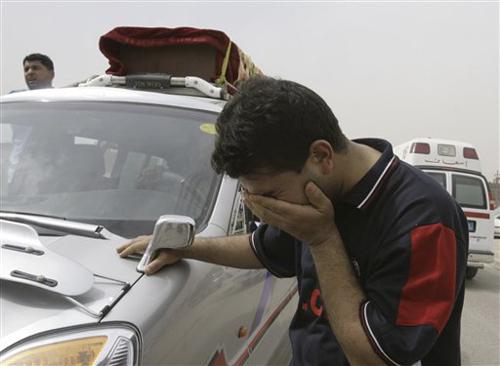Militia, government clash in Iraq

A man cries for his relative killed in clashes between Mahdi Army militia fighters and the Iraqi government forces backed by the US military in the Shiite stronghold of Sadr City, in Baghdad, Iraq, Wednesday, March 26, 2008. Karim Kadim, The Associated Press
Mar 27, 2008
BAGHDAD – Shiite militiamen are everywhere. Police and Iraqi army checkpoints are nowhere in sight. U.S. soldiers are keeping their distance.
Sadr City – the Baghdad nerve center for the powerful Mahdi Army – is suddenly back on edge as the militia leader, Muqtada al-Sadr, and Iraq’s government lock in a dangerous confrontation over clout and control among the nation’s majority Shiites.
The epicenter of the showdown has been the southern oil hub of Basra, where clashes have claimed dozens of lives this week and al-Sadr’s forces face a Friday deadline to surrender.
But a more finely tuned measure of the tensions may be found among the one- and two-story homes and shabby storefronts of Sadr City. As the crisis deepened, The Associated Press toured Sadr City on Wednesday to observe its rapid swing from relative quiet to a return of the Mahdi Army swagger before the U.S. military troop buildup in Baghdad last year.
Sadr City – named after Muqtada al-Sadr’s father, who was assassinated in 1999 – is seen as critical to the overall stability and security of the capital.
Get The Daily Illini in your inbox!
A resurgence of Madhi Army attacks and opposition could roll back the gains that have allowed Baghdad residents to take cautious steps toward normal life and offered Washington hope of accelerating troop withdrawals.
But recent days have resurrected old challenges.
Al-Sadr’s militia forces, estimated at about 60,000, now seem itching for a fight.
The current crisis came to head over U.S. and Iraqi raids that have detained hundreds of Mahdi Army loyalists even as the group maintained a shaky cease-fire since August – which the Pentagon has credited for helping bring down violence.
The tensions have spilled over into street battles in Basra between Mahdi fighters and Iraqi government forces. Fighting also has flared in other cities across southern Iraq’s Shiite heartland – where Iran is hedging its bets by supporting factions of the Mahdi Army and its main Shiite rival.
Mahdi fighters also are blamed for a series of rocket barrages on the U.S.-protected Green Zone, which was hit again Wednesday. The Pentagon appears to want no part of the current troubles. Commanders worry that American troops could be drawn into difficult urban conflict, sapping energy from the fight against al-Qaida in Iraq and other Sunni insurgents.
U.S. forces have made only sporadic stabs into Sadr City, choosing instead to strengthen a security cordon on the outskirts. U.S. commanders, meanwhile, have a limited presence in southern Iraq and show no signs of diverting soldiers – as they did in the last major fight against the Mahdi Army in 2004.
“We are a different force than the one you saw in 2004,” a senior Mahdi commander said at his Sadr City home.
“We are now better organized, have better weapons, command centers and easy access to logistical and financial support,” added the commander, who spoke on condition of anonymity because he is not authorized to speak to the media.
Squatting on the floor next to two of his fighters, the commander sipped sweet black tea as a U.S. helicopter flew low overhead. A burst of gunfire rang out at one point. Another moment, he listened to the screech of a rocket.
“That’s going to the Green Zone,” he said.
When one of his fighters left the house, he warned about driving too close to American patrols on the edge of the district – a grid-pattern of teeming streets in northeast Baghdad built in the 1950s to house poor Shiite workers.
It was first named Revolution City. Then it became Saddam City. After Saddam Hussein’s fall in 2003, it was designated Sadr City after al-Sadr’s father, Mohammed Sadeq al-Sadr, whose death is blamed on Saddam agents.


